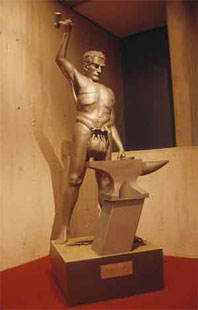The Significance of Tubal-Cain
and the Usefulness of the Blood of Abel
 “…you have come… to the blood of sprinkling that speaks [more useful, more serviceable, more advantageous] things than [that of] Abel.” Hebrews 12:22-24
“…you have come… to the blood of sprinkling that speaks [more useful, more serviceable, more advantageous] things than [that of] Abel.” Hebrews 12:22-24
In Biblical Horizons newsletter 203, James Jordan argues that since Cain’s “exodus” to build a city occurred around 130 years after the Fall, he was publicly humiliated before thousands. He would have been accompanied by at least 1000 people, so he didn’t build the city on his own.
This means that Adam, like Solomon, was father to a divided kingdom. 1 Kings presents Solomon as a new Adam, even down to his naming of animals in his biological studies. Cain was like Jeroboam, shown mercy, given a chance, but who then caused Israel to sin.
What does Genesis give us after this? We have Adam as a failed Moses, Cain in a corrupt exodus. What follows after the murder of Abel is the construction of a false Tabernacle in the wilderness. The list of the talented is a corrupt artisans guild. It is the Aholiab and Bezalel from hell. (No wonder the Freemason password is Tubal-Cain.) [1]
Their father, Lamech, was a murderer behind a pretence of justice. The authority to execute murderers was not given by God until He gave it to Noah. Lamech took vengeance into his own hands and sang it as liturgy at the Altar of the Abyss. Cain’s rage was institutionalised. It reached full term in Genesis 6, with intermarriage between the two kingdoms.[2] A violent society was the outcome of innocent blood shed at the Altar.
Why did the blood of Christ then speak of greater things than the blood of Abel, crying as a witness [martyr] from the ground? Abel’s blood was not avenged until the flood. The author of Hebrews was calling his readers to be courageous and reassuring them that the blood of the martyrs would be avenged. Just like Abel, vengeance came like a flood. In fact, vengeance for the blood of all the martyrs from Abel onwards fell upon that generation. As men were (idolatrously) marrying and giving in marriage, with murderous wives like Herodias, an Athaliah and a Jezebel, the false Tabernacle was washed away in a sudden destruction.[3]
_____________________________________
[1] See Unashamed Artisans.
[2] See James Jordan’s very interesting The Nephilim Factor.
[3] See My Brother’s Keeper, The Sons of God and the Daughters of Men and Esther’s Evil Twin.


























November 2nd, 2009 at 8:11 pm
This made my day
November 2nd, 2009 at 8:12 pm
Btw, how can I get a copy of Totus Christus?
November 2nd, 2009 at 9:15 pm
Hiram
Thanks!
Only from me at the moment I’m afraid. And the postage is a bit of a deterrent:
http://www.bullartistry.com.au/wp/2009/10/07/fresh-from-the-oven/
November 5th, 2009 at 5:26 pm
The fact that Cain feared vengeance probably suggests that the death penalty already existed prior to the flood. The idea that God would wait 1000-2000 years to implement such an important tool of justice almost resembles dispensationalism. Rather, I think God just explicitly commanded it in Genesis 9:6, to contrast with his advice that we eat animals. The OT doesn’t record everything in history, and it actually leaves a lot of extraneous info out. We kinda have to glean it through our own common sense.
November 5th, 2009 at 5:33 pm
Fair point. Although I think there is a greater significance in Noah’s office than we usually hear about. Adam had failed to be a judge. And we don’t know if the vengeance Cain feared was legal. After all, God took steps to protect him from what he deserved, just as He had with Adam and Eve.
If Abel’s death was the first murder, it is unlikely there was a need for the death penalty anyhow. I think it was a very different world.
December 22nd, 2009 at 1:54 pm
Does the flood imagery of Matthew 25 come into play in this at all? It seems it would. The Coming of the SoM like a flood would be as an avenger of the blood of the martyrs, no?
December 22nd, 2009 at 2:08 pm
I believe so. Jesus’ reference to intermarriage links it with the crucial phrase “the sons of God.” It is all about the priestly mediators getting wiped out. Just as the fountains of the deep and the floodgates of heaven brought the deluge, in the Tabernacle paradigm, it is the nations/waters of the Gentile “outer courts” flooding up over the Bronze Altar (which symbolises the Land) and the waters of the Bronze Laver “above” it pouring down and washing it clean.
See also: http://www.bullartistry.com.au/wp/2009/12/11/envy-and-the-sons-of-god/